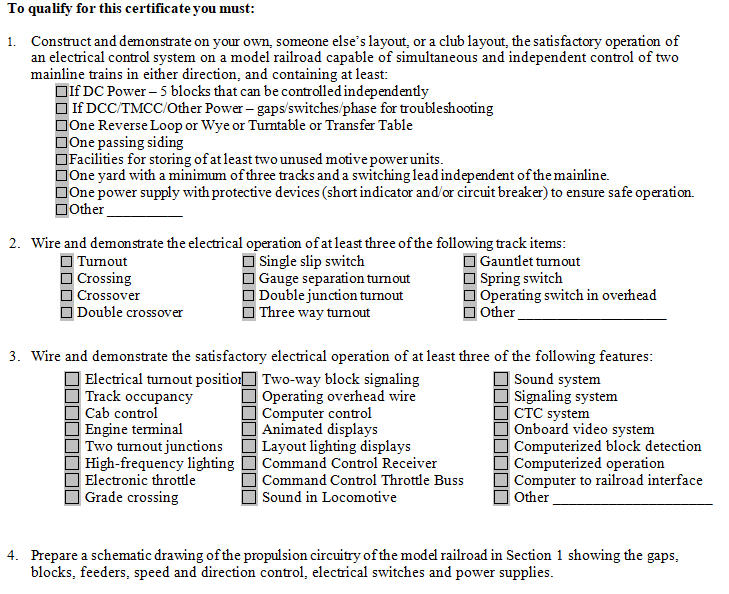Gateway Division NMRA Achievement Program Working Group - Electrical Engineering
This group was formed in November, 2021 to assist NMRA members in completing the requirements for the NMRA Electrical Engineering
AP Certificate. Our committment to each other is to assist ourselves in submitting the Statement Of Qualifications (SOQ)
by the end of June, 2022.
This section of the web site will list resources that Dave Ackmann, chair of the AP Program for the Gateway Division and moderator of the Group,
has found useful.
Enjoy!
Requirements in a Nutshell:
The requirements for the AP Electrical Engineering Certificate are available on NMRA.ORG, and at first glance are quite intimidating.
But if you look at the SOQ and how many of the requirements are optional, it begins to look
more manageable. Of course, the requirements at the web site govern, but the KISS rule applies.


Track Items: Several of these were not familiar to me, so I looked them up on-line.
Here is what I found.
Crossing: Well, I do know what a crossing is, but I was surprised that all we have to do is buy a
commercial crossing from Atlas or other manufacturer and run trains in both directions. It's just that simple.
Spring Switch: This is a turnout that is not normally manually operated at all, but is held in one position by a spring.
When it is approached from the opposite direction, the points move by the weight of the locomotive and there is no derailment.
I found no vendor that builds spring switches in HO.
Gauntlet Switch: This really isn't a turnout at all, but a way to combine two tracks into a bit more than one.
The rails are brought within a foot or so of each other so that they share ties, but take up less space. This might be used
for when Engineers want to be able to send two tracks over a small bridge, and then spread them out at each end, but don't want the expense of a turnout.
To learn more click here.. I found no vendor that that builds gauntlet switches
For more information on model train turnouts in general from TheSpruceCrafts,
click here.
For a general overview of turnouts on Wikipedia click here.
Another good descriptions of turnouts is on Railsystem.net/turnouts.
A Clinic: Proof It Can Be Done:
In 2019 at the Liberty Bell regional convention, a presentation was made on how to wire a model railroad which would meet the requirements of
Sections A and B. They did so in under 2 hours, but the presentation is condensed into 25 minutes. The first 3.5 minutes show the layout coming together
mechanically in stop motion, and the remainder of the video show the wiring and proof of operation. They use snap-track for simplicity of assembly.
Although the video is available at the NMRA web site, you may
click here
to see it as well. Login credentials will be required.
DC or DCC:
The requirements for the Electrical Engineering AP Certificate were written mainly in the Direct Current (DC) era of model railroading,
but a lot has happened since then, mainly Digital Command Control (DCC). The requirements can be satisfied either way, or even with a hybrid approach.
A lot of the documentation at the NMRA.ORG web site is oriented to DC and "Double Pole Double Throw" switches, but if you are into DCC,
you probably have made a lot of this work already. This section eventually will address some of the ways Electrical Engineering is done with DCC.
The Engineering Drawing: For me, the hardest thing appears to be creating the engineering
drawing of the propulsion circuitry for my layout. My basement layout is.about 22 by 22 feet, and while it runs well, there is a lot of detail
in documenting the gaps and electrical attachments. I am considering starting from scratch with an "N" Scale layout on a
2 by 4 foot sheet of plywood and demonstrating my Achievements on it, and I may do so for portability and demonstration at future clinics.
HOWEVER, I did the deed, measured the plywood and drew the surface in PowerPoint. But PowerPoint is not the tool to draw the track. I did try SCARM
software (and its clone software from Atlas), but found it rather difficult to use. I am now trying to use ANYRAIL6 software, and I think
it is more promising. Both programs have free trial versions, and complete licenses (which allow your layout to be larger than 50 components)
are available for $39 and $59 respectively. I thing they are going to be worth the price. BTW, Ron March, Superintendent of the Turkey Creek
Subdivision in Kansus City has a good
YouTube tutorial on ANYRAIL6.
Documentation:
In this era of COVID19, it may be difficult to get together and demonstrate that we have met the requirements. This section is a work
in progress, but I hope to demonstrate how the use of a camera or cell phone to record our accomplishments can be used to document our
work satisfactorily. But documentation is not only showing what we have done, but claiming our work on the Statement Of Qualification, or "SOQ".
If you haven't done so already, download the SOQ in PDF form by
clicking here.
or in Microsoft Word Format by
clicking here.
If you have MS Word, I suggest the latter, because you can modify the file to check off the options you wish to use for your certification,
and perhaps color code the check boxes in red to indicate options you intend to take, and then change the colors to green when
you have completed the task.
I have started a document which shows how I have implemented various components required in the SOQ. This document gives the details and links to
movies that show the actual components in operation.. To view this document
click here
18:46 22 December 2021

